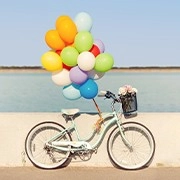Cranes of Hope

Origami paper cranes, originating from Japan, are an ancient and widely recognized art form symbolizing good fortune, happiness, and hope.
Crafted from a multitude of meticulously folded small paper pieces, they hold a special significance due to their association with the fulfillment of a wish and a range of profound symbolisms.
Peace and Harmony:
Origami paper cranes are synonymous with peace and harmony. This emblematic representation of peace persists to this day, as paper cranes are frequently used in commemoration of peaceful initiatives and to advocate against violence.
Wishes Come True:
The intricate folding process of paper cranes requires concentration and patience, making it an activity that nurtures one's character. In the tradition of folding a thousand paper cranes and then making a wish, it is believed that one's wish will be granted.
Flowers hold cultural and symbolic importance all over the world, and Italy is no exception.
Wind energy transforms global power landscape.
Embark on a global odyssey to unearth the captivating beauty and diverse wonders of islands around the world.
Matching your tires to the road.
Children's motorcycles are a fun toy that allows children to ride freely.
The health benefits of green fruits and vegetables.
This belief has elevated the paper crane to a symbol of hope, dreams, and the realization of wishes.
Hope and Optimism:
Paper cranes also symbolize hope and optimism. The act of folding paper cranes is a testament to the investment of time and patience in the pursuit of hope.
Though fragile, the image and beauty of paper cranes represent the fragility and preciousness of life, reminding us to maintain hope in the beauty of life despite its fragility.
Gratitude and Blessings:
Paper cranes are emblematic of gratitude and blessings. In various cultures, they are given as gifts to friends, relatives, or patients to express good wishes and prayers. This practice underscores paper cranes as joyous and encouraging gifts, symbolizing goodwill and kindness toward others.
Tenacity and Perseverance:
Folding origami cranes is an endeavor that demands tenacity and perseverance, involving the repetitive folding of small paper pieces with precision.
This symbolizes the determination and persistence required to overcome challenges and obstacles in the pursuit of one's goals. Paper cranes are also employed to encourage individuals to persevere and chase their dreams, even in the face of adversity.

Beauty and Creativity:
Origami cranes epitomize the value of beauty and creativity. The folding process offers creative freedom, allowing people to craft unique paper cranes in various colors and styles. This highlights the significance of creativity and beauty in bringing aesthetics into daily life.
Prayers for Recovery:
Paper cranes are also associated with recovery and healing, stemming from the poignant story of Sadako Sasaki, a Japanese girl who developed leukemia following exposure to radiation from a nuclear blast.
Sadako began folding paper cranes, believing that crafting a thousand would lead to her recovery. While Sadako did not ultimately survive, her unwavering determination and aspiration inspired others. The paper crane subsequently evolved into a symbol of recovery and the fight against illness.
Gifts and Friendship:
Paper cranes make heartwarming gifts for family and friends, serving as a gesture of friendship and affection. In Japanese culture, gifting paper cranes is a special way of conveying goodwill and fondness towards the recipient.
This cultural tradition has endowed the paper crane with a symbol of friendship and gift-giving.
Environmental Protection and Sustainability:
Origami crane folding is an eco-friendly activity as it exclusively employs paper without generating excess waste.
This symbolism resonates with sustainability and environmental awareness, underscoring that individuals can express themselves through uncomplicated handmade artistic activities without adverse effects on the environment.
In conclusion, origami paper cranes are steeped in multi-dimensional symbolism. They represent peace, hope, wish fulfillment, gratitude, resilience, beauty, healing, friendship, environmental protection, and sustainability.
Whether marking special occasions, conveying friendship and love, or pursuing dreams and recovery, paper cranes play a pivotal role. This elegantly simple handmade art form transcends cultures, serving as a powerful tool for individuals to convey their emotions and values.
The symbolic depth of the paper crane extends across various dimensions, urging people to reflect on the meaning and purpose of life.

 · Information Team
· Information Team